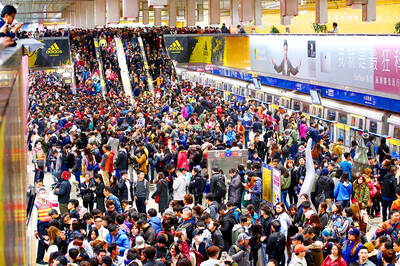The Genetic Modification-Free Zone Alliance yesterday called on elementary schools nationwide to stop providing fodder-grade soybeans in school lunches.
As elementary and junior-high schools are now calling for bids for one-year or two-year contracts to provide school lunches, the lunch evaluation committee at each school should incorporate “non-genetically modified soybean food products” as an evaluation item, said the alliance, which includes the Homemakers United Foundation, the Homemakers Union Consumers Co-op, the Green Formosa Front and the Seed Lab of National Taiwan University’s agronomy department.
“Most of the soybean food products Taiwanese consume are made of imported soybeans and according to Department of Health statistics, 90 percent of imported soybeans are genetically modified [GM] beans,” foundation secretary-general Huang Chia-lin (黃嘉琳) said.

Photo: Lin Chia-chi, Taipei Times
Vendors refer to GM soybeans as “fodder soybeans,” Huang said.
“In exporting countries, soy oil is extracted from GM soybeans and the soy grits left behind are used as livestock feed. This is why they are called fodder soybeans,” Huang said.
A survey conducted by the foundation found that of the 20 or so types of vegetables provided in school meals in a five-day week, four to seven kinds are soybean products.
Warren Kuo (郭華仁), an agronomy professor at National Taiwan University, said that compared with Japan and South Korea, whose soybean self-sufficiency rates are 6 percent and 9 percent respectively, Taiwan has an extremely low 0.05 percent.
“Out of the 200,000 tonnes of soybeans imported annually, only 20,000 are food-grade soybeans,” Kuo said.
Fodder-grade soybeans imported from the US and Brazil expose consumers to three health hazards, Kuo said.
“First, the imported soybeans are not packaged, so transporters have to apply antimicrobials to them to inhibit the growth of molds. Second, the beans are genetically modified. Third, the level of herbicide residue is high in GM products,” Kuo said.
A parent, surnamed Chang, urged the government, schools and parents to face up to the potential health risk of GM food.
“This is not just a problem for my six-year-old. GM products pose a threat to his reproductive health as well, so it is a problem for the children of my child,” Chang said.

People can take the Taipei MRT free of charge if they access it at Nanjing Sanmin Station or Taipei Arena Station on the Green Line between 12am and 6am on Jan. 1, the Taipei Department of Transportation said on Friday, outlining its plans to ease crowding during New Year’s events in the capital. More than 200,000 people are expected to attend New Year’s Eve events in Taipei, with singer A-mei (張惠妹) performing at the Taipei Dome and the city government’s New Year’s Eve party at Taipei City Hall Plaza, the department said. As people have tended to use the MRT’s Blue or

Civil society groups yesterday protested outside the Legislative Yuan, decrying Chinese Nationalist Party (KMT) efforts to pass three major bills that they said would seriously harm Taiwan’s democracy, and called to oust KMT caucus whip Fu Kun-chi (傅?萁). It was the second night of the three-day “Bluebird wintertime action” protests in Taipei, with organizers announcing that 8,000 people attended. Organized by Taiwan Citizen Front, the Economic Democracy Union (EDU) and a coalition of civil groups, about 6,000 people began a demonstration in front of KMT party headquarters in Taipei on Wednesday, organizers said. For the third day, the organizers asked people to assemble

Taipei is participating in Osaka’s Festival of Lights this year, with a 3m-tall bubble tea light installation symbolizing Taiwan’s bubble tea culture. The installation is designed as a bubble tea cup and features illustrations of Taipei’s iconic landmarks, such as Taipei 101, the Red House and North Gate, as well as soup dumplings and the matchmaking deity the Old Man Under the Moon (月下老人), affectionately known as Yue Lao (月老). Taipei and Osaka have collaborated closely on tourism and culture since Taipei first participated in the festival in 2018, the Taipei City Department of Information and Tourism said. In February, Osaka represented

Taiwanese professional baseball should update sports stadiums and boost engagement to enhance fans’ experience, Chinese Professional Baseball League (CPBL) commissioner Tsai Chi-chang (蔡其昌) told the Liberty Times (sister paper of the Taipei Times) in an interview on Friday. The league has urged Farglory Group and the Taipei City Government to improve the Taipei Dome’s outdated equipment, including relatively rudimentary television and sound systems, and poor technology, he said. The Tokyo Dome has markedly better television and sound systems, despite being 30 years old, because its managers continually upgraded its equipment, Tsai said. In contrast, the Taipei Dome lacked even a room for referees